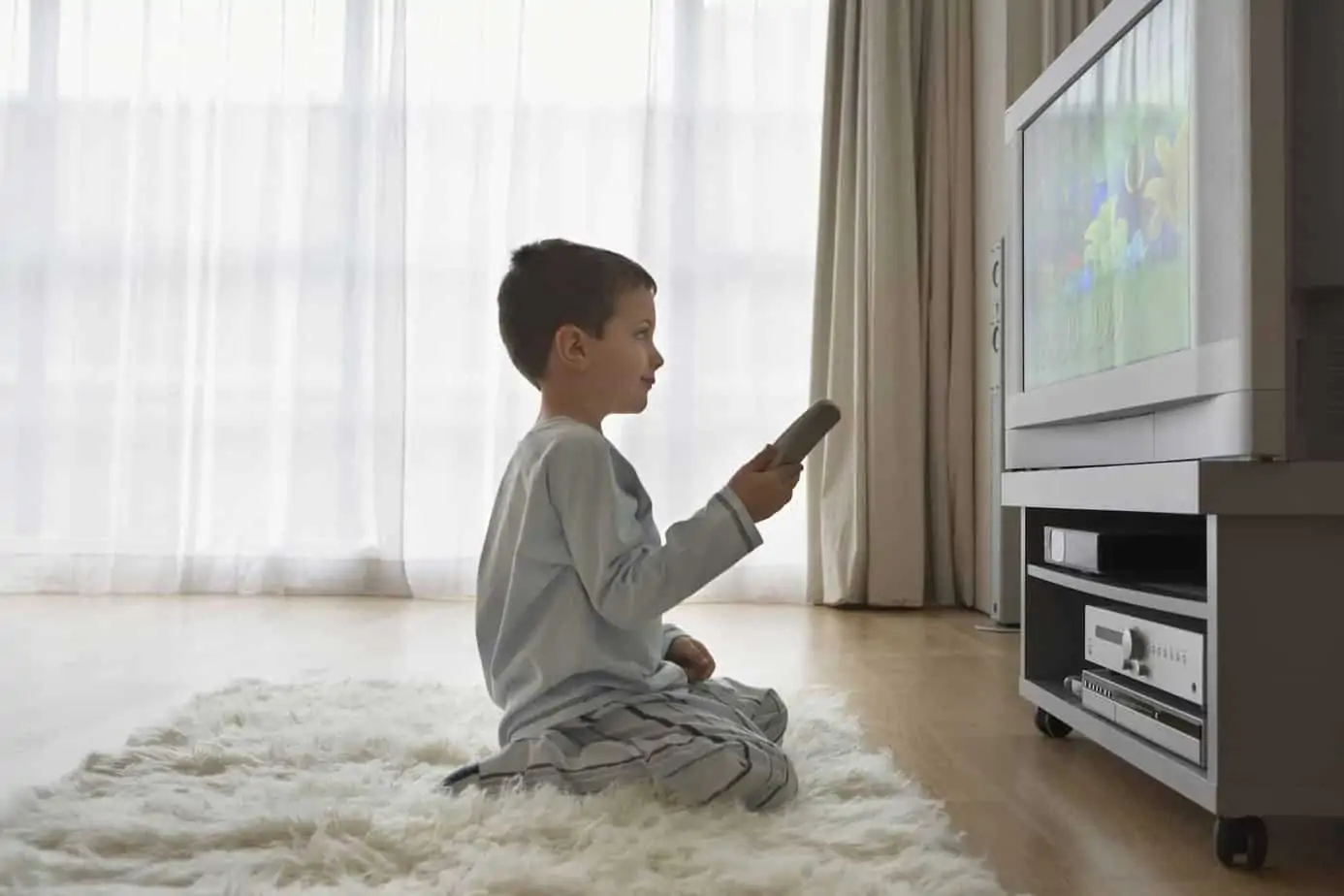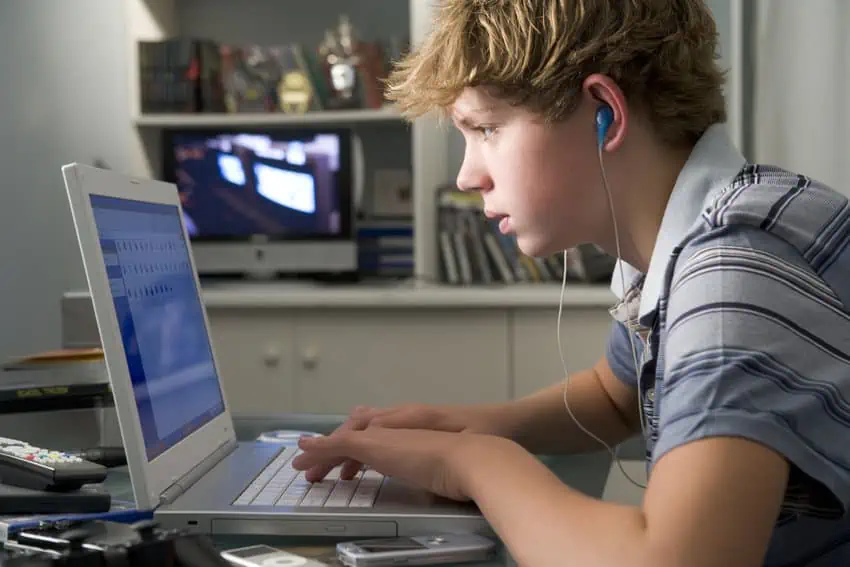The benefits to liming screen time with kids but how to do this without tears, tantrums or a fit when it’s time to hit the off button. Why limited screen time is so important and how to enforce screen limits. Plus, how to stay aware of dangerous apps and programs kids may be using in the Online Safety Handbook for Parents.
Limiting Screen Time with Kids: Why & How to Enforce Screen Limits
This is a very popular topic amongst online Mom’s groups, and my inbox this week has been full of parents asking for help to set limits on screen time.
In a recent email, I mentioned my kids don’t get anymore than one hour of screen time per day and they don’t fight me about it, throw a fit or balk when the time is up.
I must have struck a chord because my inbox has been full of parents asking the same question – how do you limit screen time without your kids screaming at your for it?
Here’s the kind of stuff parents said to me… which may resonate with what you’re seeing at home, too:
- All my son wants to do is watch TV
- My daughter can’t seem to play with her toys very long before she asks to get on her iPad (or kindle or watch tv…)
- My kids don’t want to play outside… they just want to use screens.
- He throws a fit unless he’s on his iPad, and sometimes it’s easier to give in.
- I need to work so I let them do what they want, but I have noticed they’re acting out more than ever and evenings are harder than normal.
Screentime is addictive, and it doesn’t do any good for our children to be on devices for hours each day.
If you’re seeing seeing difficult behavior when it’s time to turn off screens take this as a clear sign it’s time to set firm limits on the amount of device and television use your child should have each day.
Set Firm Boundaries to Limit Screen time:
As a parent, it’s your job to set a daily time limit on screens and it’s also your job to enforce it.
Children who have firm boundaries from their parents will respect these limits, and when you are consistent in enforcing your rules, it shows them where the line is drawn. When screens go off, they understand the rules and then there’s no reason for tears or tantrums.
Now, there are also creative ways you can incorporate into your daily life to encourage your kids to earn their screen time, in whatever amount your family decides upon, which is a win-win for parents and kids.
Setting limits on screen time doesn’t make you a “mean parent,” it makes you a responsible one who has the best interest of their child at heart.
What Does Limiting Screen Time Help?
Studies have shown any more than one hour a day of screen time can be detrimental for young kids.
>> ONE HOUR OF SCREENTIME.
That’s all you have before before unhealthy psychological effects becomes harmful to sleep, physical and mental well-being and even the connection you have with your child.
One hour per day means the time between television, tablets, phone usage, gaming systems and even portable entertainment centers in your car.
It’s been researched that children who use electronics for one hour or less per day, have the same well-being, as well as normal level of anxiety and depression, as children who weren’t exposed to screens at all during the day.
There is a strong connection between screen time and adverse effects it has on sleep, vision, physical health, mental health, and friendships and family relationships when children of any age exceed the 60 minute threshold of daily usage.
In the last decade, screen time on tablets, gaming, watching movies and television, using phones and other devices, has replaced more traditional childhood activities like you and I, as adults likely experienced.
Studies show that today’s children spend less time outside and engage in less physical activity than previous generations.
Less screen time means spending more time using their imagination, reading, being creative and getting outside to play!
Related: Harmful affects to excessive screen time with kids
If you want more help knowing how to safely navigate social media apps and the Internet, the Online Safety Handbook gives you guidelines for setting safe online use, dangers inside the most 31 popular apps, safety filters and protective safeguards parents can install on devices and home WIFI to block unsafe content, and workarounds kids use these days that parents need to be aware of.
How do I Limit my Child’s Screen Time?
Yes, this time of life on “stay at home orders” is weird.
Super weird in fact. I know it’s unprecedented and we’re all doing the best we can with our individual circumstances, but listen up. You need to hear this.
The amount of screen time your children have, is completely up to you.
That’s right. I said it.
You are in charge, not your child.
If they’ve having too much screen time, or behaving badly after using screens, it’s not their fault. It’s yours.
If they’re getting upset when it’s time to hit the off button, I’ll share exactly what we do in our house so we stick with one hour a day and help your kids understand when time’s up, there are not fits or tantrums about it and to go find something else to do.
(I promise, I’m not here to shame you or make you feel bad. There are ways you can set limits on screen time and get your kids involved with earning their screen time, so hang with me because I’m going to tell you exactly how to do it all.)
Step 1: Set a Time Limit on Devices and Screens
Whatever the time limit is you decide upon – be prepared to enforce it down to the second.
Once the time is up, it’s up and that’s it.
It’s just like setting boundaries for anything else in parenting. If you don’t follow through on it, your kids will quickly learn they can push those boundaries – and they will!
We set a one hour limit on all screens and track it – the most important part of limiting screen time – and once the time is used, it’s gone for the rest of the day.
That means, if they use their time in the morning, there won’t be any more later in the day.
Stand strong parents. I know it’s not easy going from hours or unlimited amount of screen time and carving it down to an hour or two, but the key to turning things around is to stick with this time limit EVERY SINGLE DAY.
No exceptions.
Step 2: Make Kids Earn Their Screen Time
Your child can use a device or watch a show if they ________________.
For my kids, they have to do their chores, finish their reading for the day and make it through the school day without a complete meltdown. If they do all of this, they can earn 60 minutes of screen time per day. If some of this gets done, it might only be 30 minutes for the day.
My youngest uses picture routine cards to remind her what she has to do to help her with chores like making her bed, cleaning up her laundry and helping feed the dogs breakfast.
We’re finding the kids play their kindles together on the couch while we make dinner and it’s been a good routine so far.
Tip: Print out this set of Screentime Rules if you need a sample or want to create your own house rules for earning screen time.
Step 3: Enforce Firm Screen Use Limits & Use a Timer
Say your kids have earned their screen time for the day and checked all the boxes they need on the screen time rules of with an allowance chart, then it’s your job as the parent to monitor their screen use.
The easiest way to do this?
Set a timer on your phone or use a kitchen timer, even a timer on your microwave will do the job.
When the alarm goes off, so do all devices. Simple as that.
When you set a boundary, it’s so important to follow through with it or else it becomes harder each time to stick to it. And worse? Your kids learn you’re a pushover and will squeeze more time out of you every day.
It’s like if you told your child they could only ride their bike in the driveway, but when you walk outside and find them riding in the street without an adult to supervise… they’d probably lose the privilege of riding their bike. Right?
Same thing goes with screens.
If a child doesn’t do their school work, or complete their reading time, or their chores, or whatever checklist you require of them, then they can’t earn screen time. If they do earn their time, then it’s still your job to monitor it.
The more you practice this step and stick with it, when the alarm goes off, your kids will understand this as well and be less reactive when it’s time to hit the off button.
Yes, it’s not something that’ll happen the first time or the first few times, but they’ll understand what the limit is and you’re going to stand your ground when you stick with the limits and don’t let anything slide.
Eventually, that’s when acceptance happens and when it’s time to turn off screens, they’ll turn it off and walk away without tears, frustration and big reactions.
Step 4: Build in Space for Kids to Earn Extra Screen Time
My husband and I do no-device day Sundays, and since we’re not on our phones or watching television, this means the kids aren’t either.
This also gives me so a little space to incentivize ways for them to earn screen time on this “day off” with a little extra of their help throughout the week.
My family uses allowance and reward charts taped to a wall in our house as a visual incentives for them. They like to see how close they are to earning screen time or a reward and constantly count their checkmarks.
It’s a win-win for parents because your child is doing their chores and responsibilities, as well as extras and good behavior to earn something special.
I might give them 15 extra or 30 extra minutes of screen time, but nothing like hours and hours on end.
Don’t give in and give endless hours on screens – rewards still need to have limits.
That basically defeats the whole purpose of setting healthy limits on screen time and I already know that when the kids play for too long they are less cooperative and I will surely see more disruptive behavior, so why would I let them earn something that leads to this? No way.
They each have a list of ways they can earn points during the day and throughout the week. On Sunday night, I tally up the points to see if they’ve earned enough points to get an extra 15 or 30 minutes of screen time as a reward. But if they don’t have enough points, then we try again the next week.
Create incentive for your kids to do good, behave well and think through their actions.
Giving them a reward of extra screen time is really easy, doesn’t cost a penny, and it’s a big incentive for kids to do the right thing throughout the week. And since this extra time can be built into your schedule and if you’re like us and don’t have screens typically on Sundays, you aren’t actually giving away “extra time” in front of a screen anyways.
At least, my kids who are 9, 9 and 5 haven’t clued into the math of this yet. 🙂
Step 5: Let Kids Be Bored Because It’s The Best Thing For Them
Even if kids are complaining “they’ve bored“ or they “have nothing to do,” don’t try to figure things out for them to do, instead let them get creative with their so called boredom.
(and don’t feel bad for it because it’s the best thing you can do for your child!)
You don’t have to give them an endless supply of activities to do and you don’t have to entertain them every minute of the day.
Send them outside to ride bikes, to play outside, load them up with chalk or fill a bucket with water and see what they come up with. Turn on the sprinklers, let them bake or make homemade popsicles, do any of these 50 science experiments or printable learning worksheets.
I’m not afraid to let my kids be bored, because I know it’s where they get the most creative and their imaginations come to life! They may complain for 15 or 20 minutes, but as long as I don’t give into screens, then I always (always) find them coming up with something fun or creative to do.
What you must be consistent about is not giving in and staying strong when the complaining and whining starts. Say no screens or no devices even when they beg you for them during these moments of “boredom.”
I really hope you’ve found this helpful for setting limits to screen use and can apply some of it, if you need, at your home, too.
A Safer & Smarter Solution for Kids with Phones
If you have children who are old enough to have their own phones, it’s important to not only monitor usage but make sure what they spend their time on is safe and appropriate. I love the Gabb Wireless phones for this reason.
Gabb created a safe phone without internet, social media, games or worries but still allows approved contacts to text (no photos can be sent), take and store photos and make phone calls. Plus, it looks exactly like a smartphone.
They also have the new Gabb Wireless smartwatch which feels like a great option for young kids who need to get in contact with their parents, be able to track location, also counts steps and has absolutely no access to social media or potentially dangerous apps.
More Resources for Limiting Screen Time & Raising Screen Free:
- Printable Screen time Rules Checklist for Kids (PDF)
- 10 Simple Ways to Limit Screen Time & Raise Unplugged Kids
- 50 Screen-Free Activities for Kids This Summer
- The Harmful Effects of Excessive Screen Time for Kids
- 6 Health Benefits of Outdoor Play & 20 Fun Outside Ideas for Kids (No Screens Allowed)
- Online Safety Handbook for Parents: Apps & Programs to be Aware Of
Want even more?
Shop All Parenting Resources
Shop all of our parenting resources from self-regulation tools and managing big emotions to building self esteem and confidence. There are resources for all seasons of life!









